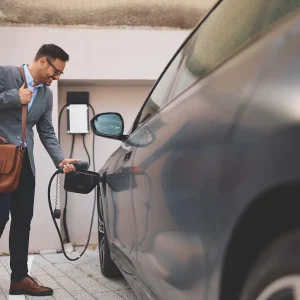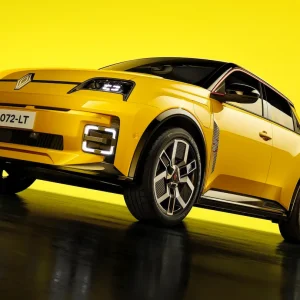BMW i7
There has been a real shift-change in the luxury car market, as far as how these models are powered. The latest Range Rover is available as a plug-in hybrid and if that’s not enough, there’s the BMW’s closest rival, the also full-electric Mercedes EQS we’re also covering here.
The i7 that we’re talking about here was launched in all-electric xDrive60 form earlier this year. However, BMW will also be offering two plug-in hybrid versions of the i7.
Whether you choose PHEV or EV power, all i7 models have four-wheel drive. Top M Performance versions are models in their own right – elsewhere there’s the choice of Excellence (our car’s spec) and M Sport. Confusingly, on top of this, M Sport Pro and Ultimate option packages can be added, although our example car was not fitted with these packs.
Outside, the looks will divide. The i7 is a tall, chunky, and distinctive design, so it’s a shame our budget wouldn’t stretch to the M Sport spec – that model’s dechrome and 21in M Star-spoke alloy wheels, would certainly sweeten the look. Like other recent BMW designs, we think the i7 will look better the more there are on UK roads.
The i7 sits on the same CLAR architecture as the X5, but this is its longest application yet, and equals a comfortable and spacious driving position in the front, but almost palatial levels of space in the back and a 500-litre boot.
There are many option packs to enhance the i7’s interior; we’ve gone with the Executive pack, which includes niceties such as Executive Lounge Rear Seats, that also massage. Considering the £120,000+ price of the car we’re focusing on, the interior feels worthy of the price in our opinion, from the soft quilted leather on the seats, to the cut-glass trim on the dash.
The BMW i7 xDrive60 is powered by one electric motor at the front axle, with the drive units delivering a combined output of 544hp and overall torque of 745Nm. Despite weighing more than 2,600kg, this i7 can sprint to 60mph in just 4.5 seconds and on to a highly illegal but equally impressive 149mph top speed.
Choose this BMW or the Mercedes and because they’re both EVs you’ll be benefitting from the lowest BIK of this group, at 2%. The Range Rover and Lexus are hybrids, and as such can’t match this figure and finish in third and fourth respectively.
With the mix of EV and hybrid models here, there are really two victors – one EV and one hybrid. The i7 has a very respectable 387-mile range, but the EV victor here is the Mercedes which goes more than 50 miles further, as the EQS has a 438 mile-range figure.
We think the BMW’s high P11D value and possible uncertainty over used EVs have resulted in the i7’s 39.27% residual figure. This puts the i7 into third position in this set, with the Mercedes finishing second, and the Range Rover at the top of the pile.
Big luxury saloons have always suffered heavy depreciation, and it seems this BMW is no different to its predecessor. With its £75,871 figure, the i7 finishes in third place here for depreciation, which is disappointing as it is the second most expensive car here with a P11D figure of £124,940. Although the BMW does have the lowest SMR figure at £3,213 and the second-lowest NI figure at £1,321.
BMW i7 xDrive60 Excellence Executive
P11D: £124,940
CO2 (tax): 0g/km (2%)
BIK: £41/£83
Range: 387 miles
National Insurance: £1,321
First year VED: £0
Subsequent VED: £0
Battery size/power: 101.7kWh/544hp
AFR: 10p
Residual value: 39.27%
Depreciation: £75,871
Fuel costs: £4,730
SMR: £3,213
Cost per mile: 139p

Lexus LS
Despite being longer and lower than the 1990 LS400 original, the look is largely the same as that car, and dare we say it, after five years on sale, maybe is a bit dated compared to more modern rivals.
Inside, the LS’s interior is spacious and has a really premium feel about it. All models get leather seats, although the LS500h model we’ve chosen to focus on has the even posher aniline leather.
The Lexus is in last place here due to its much higher operating cost, given it is just a hybrid and its fuel costs will be double what the Range Rover will be and almost three times those of the i7 and EQS.
The Lexus also suffers with National Insurance costs that are based on it being a 37% band car, compared with the 2% band of the EVs and the Range Rover at 5%, due to its 72-mile range. The one thing in its favour is that it has the cheapest P11D figure here at £119,115.
Lexus LS500h Leather-Aniline
P11D: £119,115
CO2 (tax): 215g/km (37%)
BIK 20/40% a month: £734/£1,469
Fuel consumption: 29.7mpg
National Insurance: £18,246
First year VED: £2,220
Subsequent VED: £560
Engine size/power: 3,456cc/292hp
AFR: 19p
Residual value: 33.20%
Depreciation: £79,568
Fuel costs: £13,258
SMR: £3,742
Cost per mile: 150p

Mercedes-Benz EQS
An all-electric S-Class, the EQS is not. What the EQS is, is the first all-electric luxury saloon from Mercedes-EQ. It is also the first bespoke model to be based on the brand’s modular architecture for luxury and executive-class electric vehicles.
Outside, from the front, the lack of an engine has had a real effect on the EQS’s styling. Much more cab-forward, with a shorter overhang, there’s no grille as there’s no need for one.
Inside, with all the soft leather on the seats, the unpolished wood on the minimalist dashboard and impressive levels of legroom in the back, you could be in an electric S-Class. There is also an excellent 12.8in central touchscreen running Mercedes’ latest MBUX infotainment system, which despite all its technology, is easy to use. Rear legroom levels also impress and there’s a 610-litre boot.
The Mercedes finishes in second place in terms of P11D (£119,115), it also has the second-highest residual value at 46.10% and is the second-lowest depreciator at £64,445, leading to its solid second position in the group.
Mercedes EQS 450+ AMG-Line
P11D: £119,115
CO2 (tax): 0g/km (2%)
BIK 20/40% a month: £39/£79
Range: 438 miles
National Insurance: £1,264
First year VED: £0
Subsequent VED: £0
Battery size/power: 107.8kWh/360hp
AFR: 10p
Residual value: 46.10%
Depreciation: £64,445
Fuel costs: £4,454
SMR: £4,543
Cost per mile: 122p

Range Rover
The all-new, fifth-generation of the ever-popular Range Rover was launched more than a year ago and boasts a new look inside and out.
There is also a seven-seater option on the table for the first time, plus short and long-wheelbase bodies with diesel, electric and petrol power. With the rest of the Range Rover collection sitting in the highest 37% BIK band, despite its considerable price, the plug-in hybrid version that we are looking at here piques fleet interest, with its 5% band.
Inside, the biggest change is the dashboard with its 13.1in tablet-style Pivi Pro navigation system, dominating the centre console. The second row of the new Range Rover means it’s an equally nice car to be driven in, especially if you go for the long-wheelbase version, although both versions get reclining seats. Boot space is a practical 725 litres.
The Range Rover is the second most expensive car in this set (P11D £121,470), but it has the highest residuals (56.58%), and depreciates the least (£52,740). These figures and the low BIK, put the Range Rover at the top of the pile, even compared with the two EVs in this feature.
Range Rover P460e HSE
P11D: £121,470
CO2 (tax): 17g/km (5%)
BIK 20/40% a month: £101/£202
Fuel consumption: 28.7mpg
National Insurance: £2,793
First year VED: £10
Subsequent VED: £170
Engine size/power: 2,997cc/510hp
AFR: 25p
Residual value: 56.58%
Depreciation: £52,740
Fuel costs: £6,138
SMR: £5,463
Cost per mile: 107p





